텍스텀 클럽(Textum Club)은 패션비평과 관련된 프랙티스와 출판을 위한 연구모임입니다. 직물을 뜻하는 ‘textile’과 글을 의미하는 ‘text’의 공통 어원인 ‘엮다’는 뜻을 가진 텍스텀 클럽은 패션 비평 아카이브로써 비평적 패션(Critical Fashion) 관련 국내외의 도서를 소개합니다.
비평적 패션 프로젝트 및 담론의 지속적 연구와 확산을 위해 전시, 출판, 연구, 워크숍 등 다양한 활동을 추진하여 국내외의 디자이너, 예술가, 연구자, 패션종사자의 네트워크장으로써 기능하고자 합니다.
Textum Club is a research group dedicated to practices and publishing in fashion criticism based in Seoul. Derived from the common roots of 'textile' and 'text,' meaning 'to weave,' Textum Club introduces books and articles related to critical fashion as part of its fashion criticism archive.
It aims to serve as a networking platform for designers, artists, researchers, and fashion practitioners globally through various activities including exhibitions, publishing, research, and workshops.
テキスタムクラブ(Textum Club)は、ファッション批評に関する実践と出版のためのリサーチグループです。布地を意味する「textile」と、文章を意味する「text」という言葉の共通の語源である「編む(texere)」という概念に基づくテキスタムクラブは、ファッション批評のアーカイブとして、クリティカル・ファッション(Critical Fashion)に関連する各国の書籍を紹介しています。
批評的ファッションのプロジェクトやディスコースの継続的な研究と普及を目指し、展覧会、出版、リサーチ、ワークショップなど多様な活動を展開しながら、各国のデザイナー、アーティスト、研究者、ファッション関係者のネットワークの場として機能することを目指しています。
-
김서희는 세히쿄(SEHIKYO) 프로젝트를 운영하며 착용자들과 협업하는 방식으로 옷을 입는 아이디어를 공유하고 있습니다. 전시, 워크숍, 프레젠테이션을 통해 전통적 패션 시스템에 의존하지 않는 대안적 프랙티스를 연구하고자 합니다.
www.sehikyo.orgThe SEHIKYO project is managed by Seohee Kim, who shares innovative ideas about clothing through collaboration with wearers. Through exhibitions, workshops, and presentations, she explores alternative practices that challenge the traditional fashion system, aiming to establish a new paradigm in how fashion is perceived and practiced. More details about her work and contributions can be found on the www.sehikyo.org
キム・ソヒはSEHIKYO(セヒキョ)プロジェクトを運営し、着用者との協働を通じて「服を着る」というアイデアを共有しています。展覧会、ワークショップ、プレゼンテーションを通して、従来のファッションシステムに依存しない代替的なプラクティスの探求を目指しています。www.sehikyo.org
-
김연우는 큐레이터, 연구자, 제작자로 활동하고 있으며, 텍스텀 클럽의 공동 창립자로서 패션 비평과 관련된 연구, 전시, 출판 활동을 수행하고 있습니다. 그녀는 2023 청주 공예 비엔날레를 비롯하여 서울과 제주에서 공예와 예술 관련 다양한 전시를 큐레이션했습니다. 연세대학교에서 철학과 의류환경을 공부한 후, 센트럴 세인트 마틴과 영국 왕립 예술 대학교에서 패션을 전공했습니다. 그녀는 패션 현상의 철학적 분석에 대한 이론과 실천을 연구하며, 패션에 대한 대안적인 시각을 제공하고자 합니다.
www.fashionknowledgehoarder.comYeonwoo Kim works as a curator, researcher, and maker, and is a co-founder of Textum Club, where she engages in research, exhibitions, and publishing related to fashion criticism. She has curated various craft and art exhibitions in cities including Seoul and Jeju, notably the 2023 Cheongju Craft Biennale. After studying philosophy and clothing environment at Yonsei University, she pursued fashion at Central Saint Martins and the Royal College of Art in the UK. She researches the theory and practice of philosophical analysis of fashion phenomena, aiming to provide an alternative perspective on fashion. More details about her work and contributions can be found on the www.fashionknowledgehoarder.com
キム・ヨヌはキュレーター、研究者、そしてクリエイターとして活動しており、テキスタムクラブの共同設立者として、ファッション批評に関するリサーチ、展覧会、出版活動を行っています。彼女は2023年の清州工芸ビエンナーレを含め、ソウルや済州で工芸とアートに関する様々な展覧会をキュレーションしてきました。延世大学で哲学と衣類環境を学んだ後、セントラル・セント・マーチンズおよび英国王立芸術大学でファッションを専攻しました。彼女はファッション現象の哲学的分析に関する理論と実践を研究し、ファッションに対する新たな視点を提示することを目指しています。www.fashionknowledgehoarder.com
-
황혜림은 시각예술 및 공예 분야에서 활동중인 큐레이터입니다. 분단, 장애, 게임, 웹툰 등 경계에 머무는 것들에 대해 많은 관심을 갖고, 연구 및 전시 활동에 참여하고 있습니다.
Hwang Hyerim is a curator active in the fields of visual arts and crafts. She has a keen interest in topics residing at boundaries such as division, disability, gaming, and webtoons, and is involved in research and curatorial projects related to these themes.
ファン・ヘリムは、視覚芸術および工芸の分野で活動しているキュレーターです。分断、障害、ゲーム、ウェブトゥーンなど、境界にとどまるものごとに強い関心を持ち、リサーチや展覧会の活動に取り組んでいます。
-
텍스텀 클럽의 활동에 관심이 있는 여러분의 참여를 환영합니다! 패션과 관련된 책이나 주제를 추천해주세요. 또한 문의사항이 있다면 언제든지 저희에게 메일을 보내주세요.
We welcome your participation in Textum Club’s activities! Please recommend books or topics related to fashion that interest you. If you have any questions, feel free to email us at any time.
テキスタムクラブの活動にご関心のある皆さまのご参加を心よりお待ちしております。ファッションに関する書籍やテーマのご推薦もぜひお寄せください。ご質問などがありましたら、いつでもお気軽にメールでご連絡ください。
textum.club@gmail.com
@textum.club
textum.club@gmail.com
@textum.club
textum.club@gmail.com
@textum.club
마리엘 마누엘: 오래된 인간의 이야기를 담은 옷
Clothes Containing Old Stories of Humans
マリエル・マニュエル: 古い人間の物語をまとう衣
1987년 스위스 모르주에서 태어난 마리엘 마누엘은 스위스/미국 국적의 예술가이자 패션 디자이너이다. 앤트워프 왕립 예술 아카데미를 졸업한 그녀는 스위스 디자인 어워드를 세 번(2011, 2012, 2020) 수상했다. 파리에서 발렌시아가와 파코 라반에서의 경험을 바탕으로 2018년에 자신의 스튜디오인 마누엘 매뉴팩처스를 설립하여 예술 작업과 컨설팅 업무를 병행하고 있다. 그녀의 브랜드 ‘마리엘 마누엘’은 전 세계 여행에서 영감을 받은 정교한 시그니처 작품을 창작하는 의류 브랜드이다.
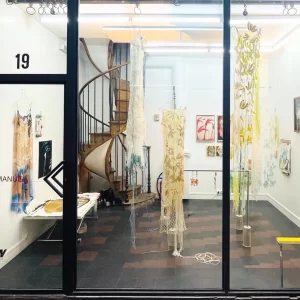
ⓒ Mariel Manuel
그녀의 컬렉션은 인도의 전통 공예 기법과 장인정신을 반영하여 제작되었으며, 바틱 프린팅, 칼람카리 염색 등 인도의 전통 기법을 활용하여 독특한 디자인을 선보인다. 특히, 남인도 첸나이와 구자라트에서 수집된 재료를 사용하여 환경을 생각한 자수와 재활용 어망 등으로 구성된 컬렉션은 의복의 지속 가능성과 예술성을 동시에 추구한다.
텍스텀 클럽은 그녀에게 디자이너로서의 철학과 함께 지금까지의 여정을 질문해보았다.
텍스텀 클럽
당신이 옷으로 작업하는 이유는 무엇인가요? 패션의 어떤 점이 당신에게 매력적으로 다가왔나요?
마리엘 마누엘
어렸을 때 저는 재봉사가 되고 싶었어요. 성장기에 세계 곳곳을 많이 여행하며 자랐는데, 아버지는 항상 타지의 현지인들과 함께하는 것이 어떤 것인지 몸소 보여주셨죠. 이 경험들은 제가 어린 나이부터 자연스럽게 사람들의 다양성과 세상을 이해하게 해줬습니다.
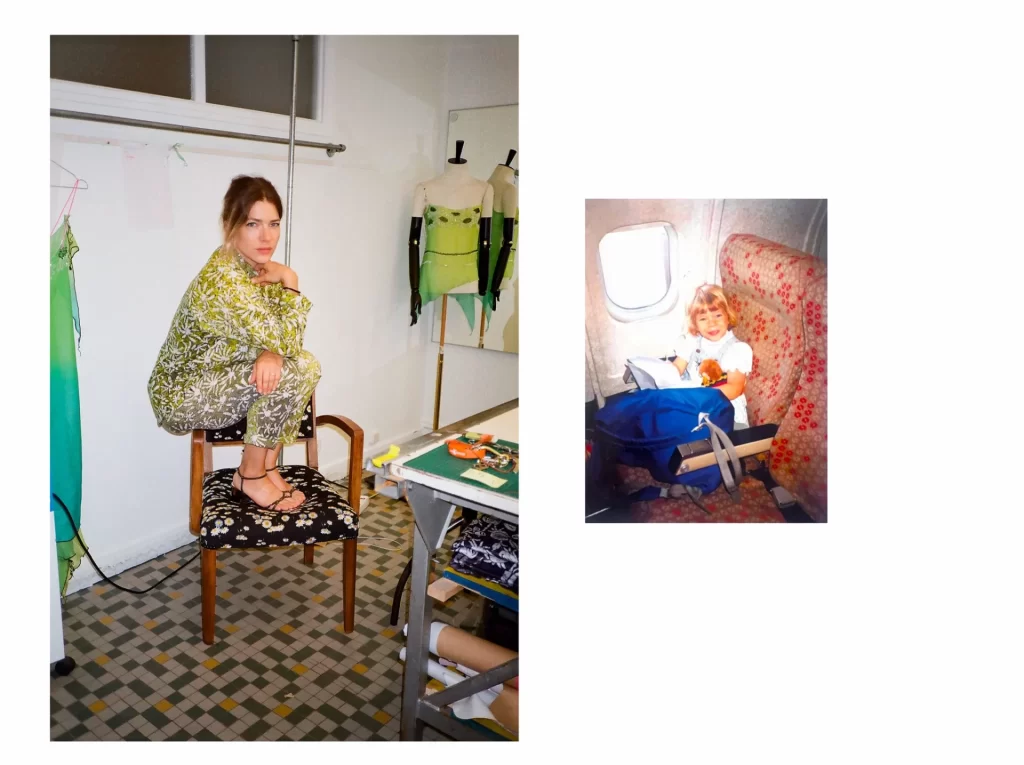
ⓒ Mariel Manuel
유년기에는 어머니와 함께 바느질하고 그림을 그렸어요. 그 시절 저는 이미 옷을 통해 하고 싶은 이야기를 하는 것에 익숙해졌던 기억이 나요. 집 선반에는 내셔널 지오그래픽(National Geographic) 잡지가 가득했고, 저는 매일 밤 부모님을 침대로 데려가 모든 페이지마다 묘사하는 세계와 그곳의 기후에서 사는 것을 상상했어요. 그 이후 우리 집 맞은편에 있는 미용실의 미용사가 프랑스 보그(Vogue) 잡지들을 내게 건네줬어요. 그때 저에게 영향을 준 두 잡지가 내 머릿속에서 뒤섞이기 시작했고, 사진 편집, 스타일링, 컬러와 메이크업 모두가 이러한 놀랍고 창의적인 영감의 세계를 반영하는 것을 보았습니다. 저에게 그것은 ‘혼합’이었고, 그 세계가 저에게 말을 건넨 것을 느낄 수 있었죠.
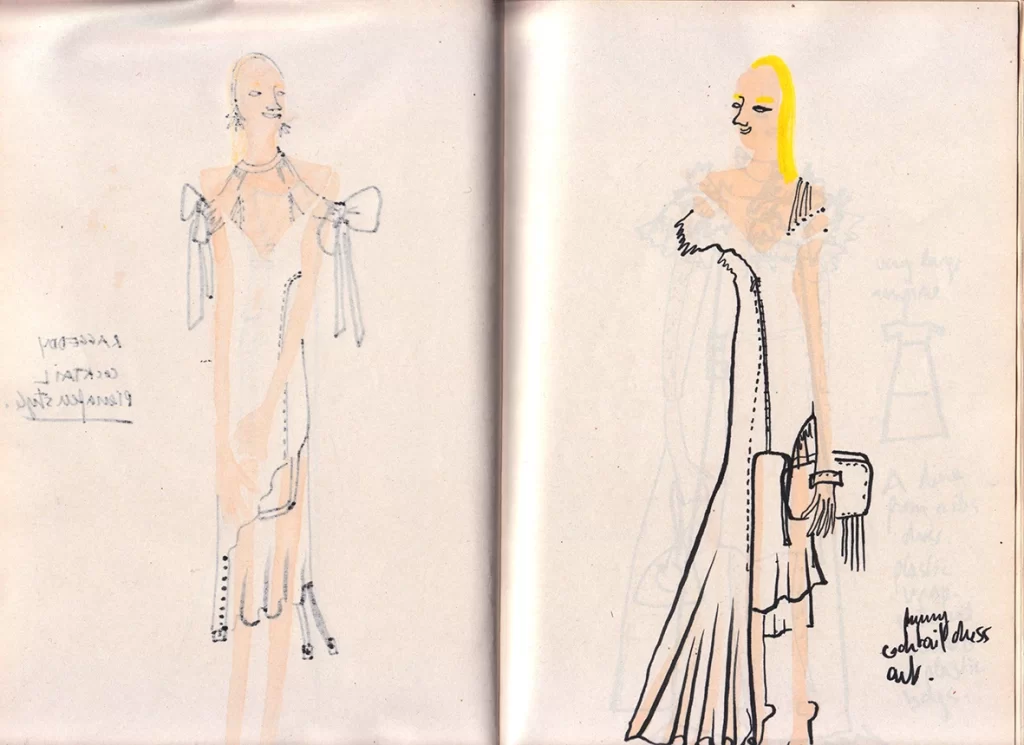
ⓒ Mariel Manuel
10대 때 후세인 샬라얀(Hussein Chalayan)의 작품에서 그가 디아스포라(Diaspora) 혹은 이주(Displacement)에 대해 말하는 방식을 알게 되었고, 시(Poetry)와 몸을 둘러싼 개념들을 통해 이야기를 번역할 수 있다는 것에 놀랐어요. 이런 경험들로 자연스럽게 기계를 조립하거나 아이디어를 많이 그리게 되었고, 특히 패션이나 옷은 인류와 가장 가까워서 더 관심을 두게 되었던 것 같아요. 특히 저는 인간의 이야기에 흥미를 느껴요. 그리고 패션은 우리가 모두 속한 인류의 강력한 도구이자 지표라고 생각합니다.
텍스텀 클럽
패션 업계에서의 경험 후, 어떻게 브랜드에 소속되지 않은 독립 디자이너의 길을 가게 되었나요? 그리고 그것은 어떤 느낌인가요?
마리엘 마누엘
여전히 패션 업계에서 많은 경험을 쌓고 있어요. 하지만 그와 동시에 패션 업계의 창의적인 사람들을 “보호”하기 위해 나서기도 해요. 우리는 쉴 새 없이 바쁜 도시의 폐쇄적인 공간에서 잘 일할 수 있는 사람들이 아니에요. 그런데도 거의 10년 동안 압박 속에서 일해왔죠.
최고의 아이디어는 마음이 차분하고 안정될 때 나온다고 생각해요. 구글에서는 직원들이 자연 속에서 쉴 수 있는 시간을 주고, 그 자연 속에서 아이디어를 얻는 방식을 취합니다.
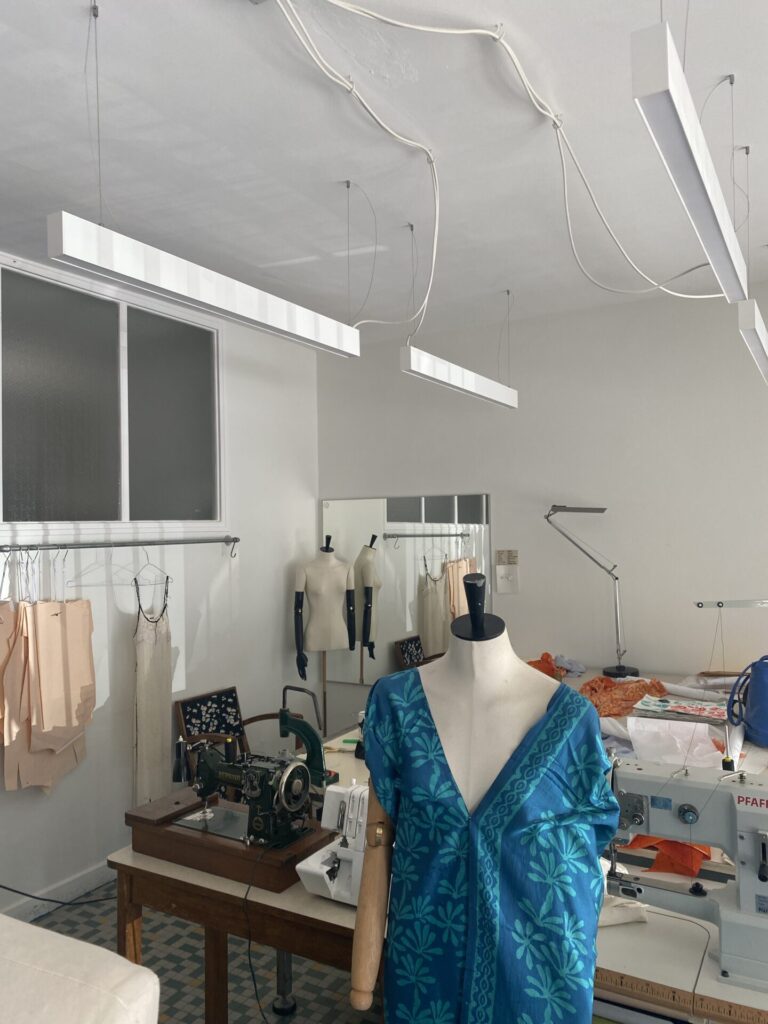
마리엘 마누엘의 작업실 전경. ⓒ Seohee Kim
지난 4년 동안 독립 디자이너로 일하면서 저에게 맞는 프로젝트에 참여할 기회가 많았어요. 디자이너가 크리에이티브 디렉터와 그들의 비전에 대해 논의할 때 생기는 불꽃을 항상 좋아해요. 그들의 이야기를 듣고 그 비전을 구체화하는 일을 하고 있죠. 그들의 비전에 맞는 아이디어로 세상을 만드는 거예요. 저는 제 작업을 그렇게 봅니다.
2020년 첫 코로나 파동 때는 스위스의 산을 배경으로 한 1900년대 장편 영화의 의상을 작업했어요. 그 당시 뉴델리에서 스위스 예술 위원회(Swiss Arts Council)에서 4개월간의 레지던시 프로그램을 마치고 돌아오는 중이었는데, 그 오래된 샬레에서 혼자 살고 있다는 걸 깨달았죠. 의뢰받은 영화의 의상을 만들기 위해 주변의 자연에 흠뻑 빠져 매일 그림을 그렸어요. 지금은 몬테베르디의 <율리시스의 귀향(Il Ritorno di Ulisse)> 제네바 오페라의 예술 연출과 의상 디자인도 하고 있습니다.
저는 항상 사람들과 이야기합니다. 상업적인 전략이든 신화적인 상상의 세계든, 항상 이야기하는 사람들을 염두에 두고 있어요. 특정한 목적에 제 전문 지식을 적용하는 걸 좋아해요. 그게 매우 정확하다고 생각해요. 그래야 사람들과 소통할 수 있다고 믿습니다.
텍스텀 클럽
장인적인 부분이 당신의 패션 실천에 중요한 역할을 하는 것 같습니다. 장인 정신이 작업에 중요하다고 생각하게 된 배경은 무엇인가요? 그리고 당신의 작업에서 다른 중요한 부분이 있다면 공유해줄 수 있나요?
마리엘 마누엘
네, 작업에서 장인정신은 저한테 정말 중요해요. 뭔가를 만드는 게 제가 지금 뭘 하고 있는지 느끼게 해주거든요. 사람들은 비즈니스를 하거나 브랜드를 키우다 보면 스스로 만드는 걸 멈추기도 해요. 저도 비즈니스도 좋아하지만, 만드는 게 제일 좋아하는 일이에요. 길을 잃거나 삶의 페이스가 떨어질 때, 다시 무언가를 만들면 모든 게 좋아집니다.
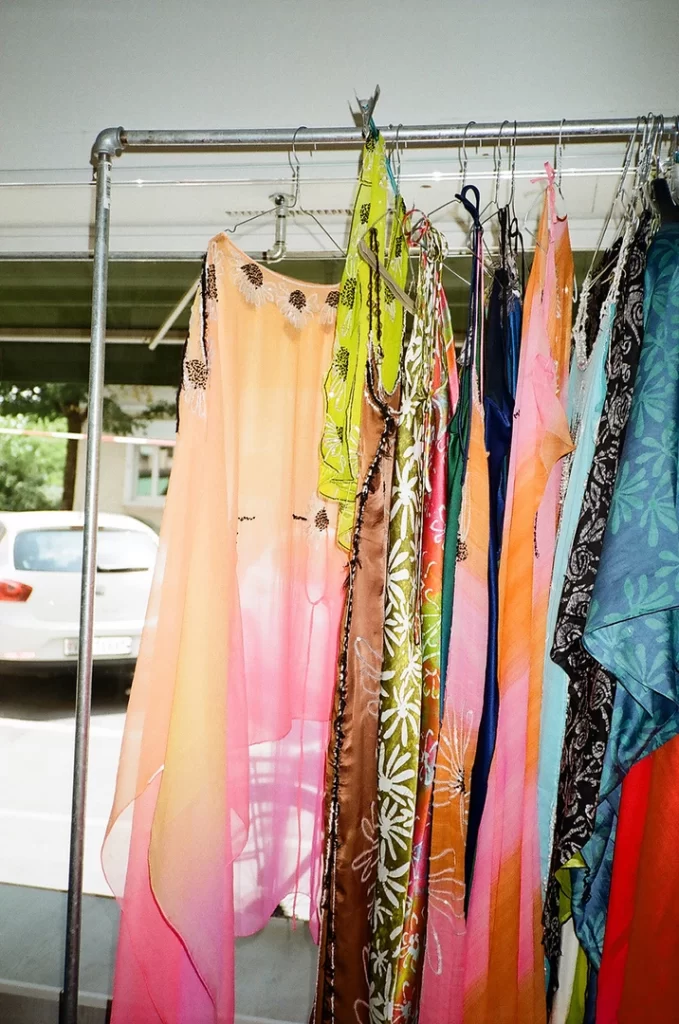
ⓒ Mariel Manuel
저는 손재주가 좋은 가정에서 자랐어요. 집에 텔레비전이 없어서 항상 엄마랑 뭔가를 만들거나 아빠랑 특수 공학 발명품으로 기계를 만들었어요. 어렸을 때 스페인에서 오렌지 주스 기계를 보고 완전히 매료돼서 아빠랑 같이 나만의 오렌지 주스 기계를 만들어 보고 싶어서 참을 수가 없었죠. 전자 부품 없이 자판기처럼 터보건 아래로 헤이즐넛이 나오게 하는 기계도 만들었어요. 그때부터 균형과 무게를 포함하는 기계 시스템에 매료됐어요. 지금도 여전히 수놓는 드레스나 원단을 자르는 방법에 이런 기하학적인 특징을 적용합니다. 모두 기하학과 가느다란 선이니까요.
그리고 저한테는 전체를 만드는 게 단순히 옷의 한 부분을 만들거나 디자인하는 것보다 더 중요해요. 사진을 찍고 소통하고, 마지막에는 전시하거나 판매하는 방식까지 통틀어 모두 저의 비전을 담고 있기 때문이에요. 모든 것은 저의 선택이고, 그것은 저에게 매우 중요합니다.
텍스텀 클럽
인도에서 레지던시 프로그램에 참여했다고 알고 있는데요. 그곳의 경험이 당신의 작업 실천에 어떤 영향을 끼쳤나요?
마리엘 마누엘
10대 때 아버지와 여동생과 함께 처음으로 뭄바이(Mumbai)에 갔었어요. 거리의 엄청난 인파와 소음을 듣고 정말 충격을 받았던 기억이 납니다. 빈곤에 대한 충격도 상당했어요.
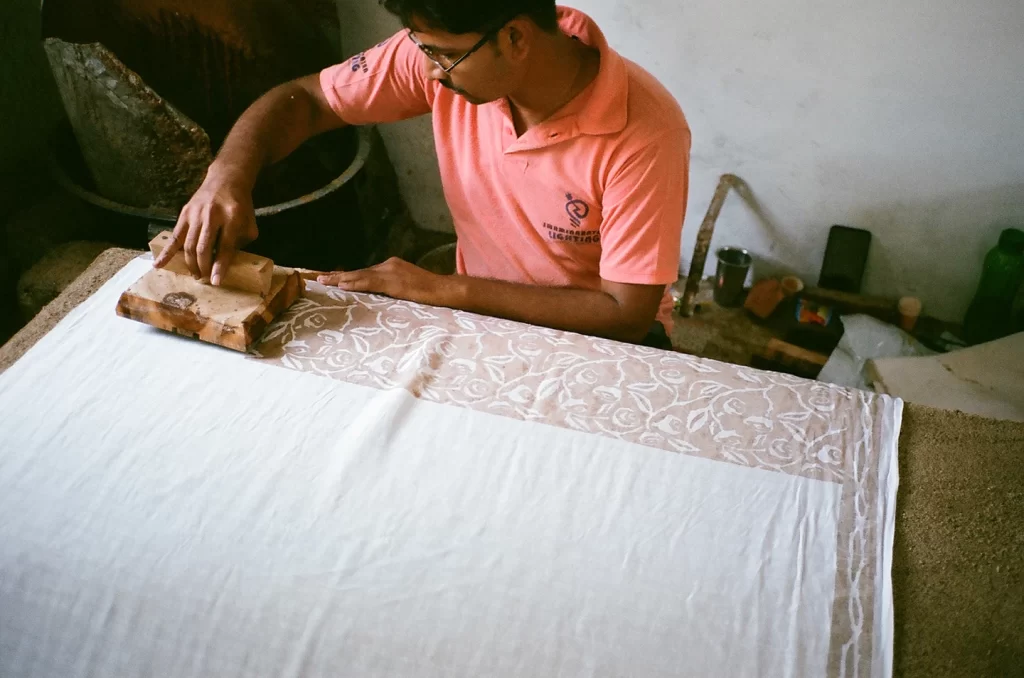
ⓒ Mariel Manuel
2016년에 다시 그곳에 가서 현지 화가를 만났고, 몇 년 동안 함께 지냈어요. 그 당시 저는 정기적으로 여행 중이었고, 가장 더운 달에는 첸나이(Chennai)에서 지내고 있었습니다. 정말 현지에서 살아보는 경험이었어요. 전 패션 커뮤니티에서 지낸 지난날들에 약간 지쳐 있었기 때문에, 첸나이에서 보고 느끼는 것들을 모두 받아들이기 위해 영적으로 꽤 열려 있었던 것 같아요.
자수를 하는 사람 한 명과 함께 일하기 시작했고, 당시 살던 곳의 작은 부엌에서 천연 염료를 만들고 모든 것을 자연 건조했어요. 그 과정은 정말 유기적이었어요. 매일 오후 5시가 되면 앵무새들이 날아다니고, 창문 아래 길가에는 채소 수레 상들이 토마토를 팔고 있었죠. 소와 개는 어디서나 돌아다니고요. 그 당시 저는 오토바이를 타며 주변의 다채로운 나무와 풍경을 보고 그것들을 그리기 시작했습니다. 바쁜 파리 생활과는 정말 거리가 먼 생활이었죠.
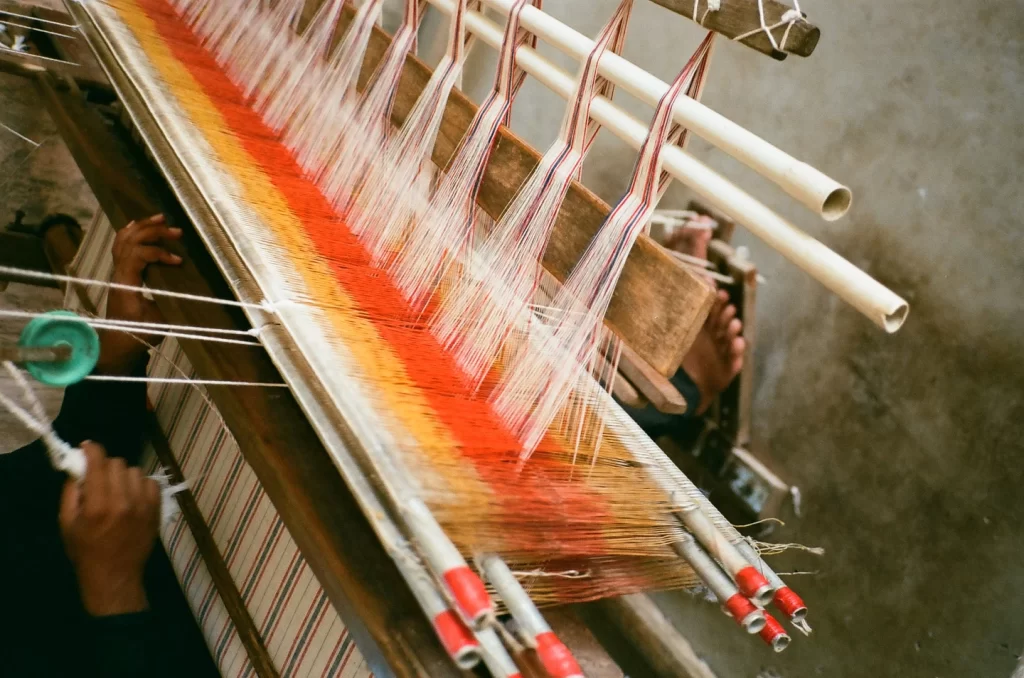
ⓒ Mariel Manuel
지난 몇 년간의 경험이 아름다웠던 만큼 생활은 힘들었고 꽤 외로웠어요. 개인적으로 많이 성장하기도 했고, 가지고 있는 것을 놓아주는 것에 대해 많은 것을 배웠습니다. 그곳은 선입견을 가지고는 지낼 수 없는 곳이었어요. 저는 많은 것을 잊어야 했고 그대로 내버려 두어야 했습니다. 하지만 또한 현지 사람들과 함께 일하면서 많은 것을 배우기도 했어요. 때때로 저는 스스로 미쳐가고 있다고 생각했지만 동시에 그냥 내버려 두는 법도 배웠습니다. 다시 집으로 돌아왔을 때는 저의 자아에 있는 많은 겹이 벗겨진 것을 느낄 수 있었습니다.
텍스텀 클럽
패션은 소비주의 문화로 강하게 인식되지만, 당신이 만드는 옷에서 다른 문화적 연결 고리가 작용할 여지가 있어 보입니다. 패션을 덜 소비주의적으로 만들기 위해 패션 디자이너로서 어떤 노력이 필요할까요? 그리고 이러한 종류의 작업이 지닌 가능성에 대해 어떻게 생각하시나요?
마리엘 마누엘
요즘 점점 더 많은 디자이너들을 만나게 되었는데, 그들은 자기만의 방식으로 실천하고 연구를 하고 있어요. 그게 정말 큰 영감을 줍니다. 패션 하우스에서 느꼈던 그 경쟁 의식은 전혀 없어요. 이건 더 나은 인간 행동의 정확한 지표라고 생각해요!
제가 존경하는 제인 구달이 말했듯이, 우리는 항상 이야기에서 감동을 받고, 사람들은 이야기를 들을 때 공감하죠. 사람들이 옷이나 패션, 직물에 대한 이야기를 잘 모르는 건, 그 이야기들이 잘 전달되지 않아서예요. 많은 새로운 디자이너들이 이제 자신의 이야기를 들려주고 있어요. 상업적인 측면에서는 좀 어렵겠지만, 예술적인 시각으로 더 많은 이야기를 할 수 있을 거예요. 사람들에게 필요한 건 이해라고 생각합니다.
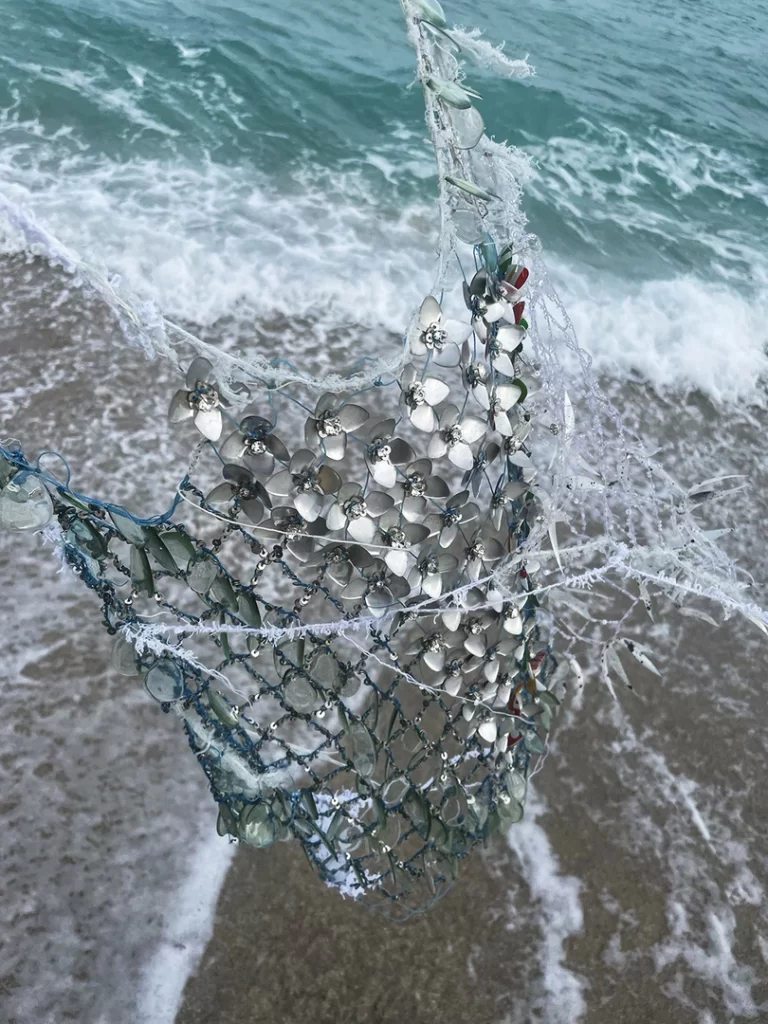
ⓒ Mariel Manuel
패션은 몸을 보호하기 위한 근본적인 목적에서 너무 멀리 벗어나 버렸어요. 엘리트주의의 궤도 속에서 우리가 뭘 하고 있는지 모르게 되었죠. 그저 이야기를 하고, 진실을 찾고, 우리가 옷에게서 빼앗고 있는 것들을 다시 돌려줘야 한다고 생각합니다. 그것의 삶에게로요.
텍스텀 클럽
스위스 제네바 예술 대학(HEAD Genève)에서 흥미로운 패션 워크숍을 진행 중이신데, 그 워크숍에 대해 좀 더 자세히 설명해 주실 수 있나요?
마리엘 마누엘
저는 지금 카리타스(CARITAS)와 협력해서 제네바 예술대학 HEAD Genève의 패션학과 학부생들과 함께 작업하고 있어요. 지금까지 두 번째 워크숍을 진행했죠. 카리타스는 스위스의 자선 단체인데, 학생들에게 가장 낮은 등급의 “텍사이드(TEXAID)” 재활용 의류 가방을 제공합니다.
저는 크리에이티브 디렉션부터 비주얼 커뮤니케이션, 쇼룸 제작까지 학생들과 함께 컬렉션을 큐레이팅하는 일을 맡고 있어요. 학생들은 실루엣과 옷의 원형을 중심으로 작업해서, 잘 꾸며진 쇼룸에 전시할 목적으로 옷에 새 생명을 불어넣고 있어요. 저는 이 프로젝트를 전체 공간과 세트 디자인으로 발전시키고 싶어요. 오래된 물건으로도 보석을 만들 수 있다는 게 이 워크숍의 핵심이에요. 이미 존재하는 모든 것에 아름다움을 더할 수 있어요.
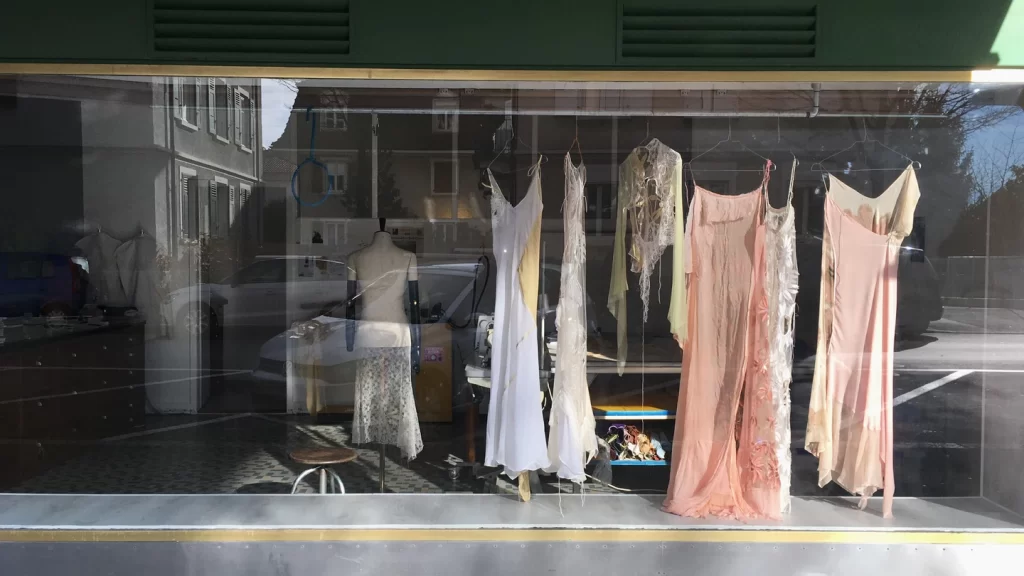
ⓒ Mariel Manuel
마리엘 마누엘의 더 자세한 활동은 홈페이지와 인스타그램으로 확인할 수 있다.
© Textum Club. 본 인터뷰의 편집 및 기획 저작권은 텍스텀 클럽에 있으며, 인터뷰이의 발언은 동의하에 인용되었습니다. 일부 권리는 인터뷰이에게 귀속됩니다. 무단 복제, 편집, 재사용을 금합니다.
Born in 1987 in Morges, Switzerland, Mariel Manuel is a Swiss/American artist and fashion designer. A graduate of the Royal Academy of Fine Arts in Antwerp, she was awarded the Swiss Design Award three times (2011, 2012, 2020). In 2018, after her experiences at Balenciaga and Paco Rabanne in Paris, she created her studio, Manuel Manufactures, under which she does both artistic and consulting work. She founded her clothing brand Mariel Manuel where she creates finely crafted signature pieces inspired by global travels.
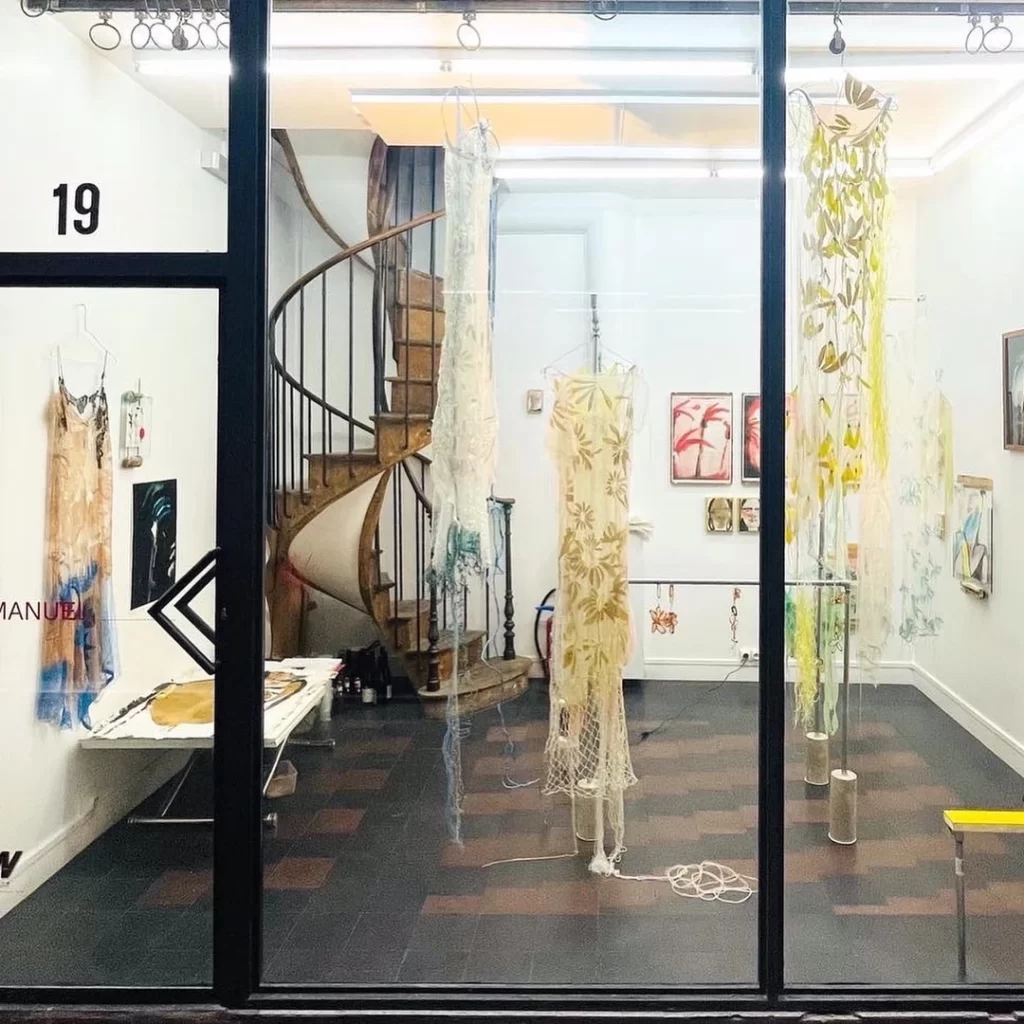
© Mariel Manuel
Her collections are crafted by reflecting traditional Indian craftsmanship and techniques, showcasing unique designs through methods such as batik printing and kalamkari dyeing. Specifically, some collections use materials sourced from southern India, including Chennai and Gujarat, and feature eco-friendly embroidery and recycled fishing nets. This approach aims to combine sustainability and artistry in her clothing.
Textum Club asked her about her philosophy as a designer and the journey she has taken so far.
Textum Club
Why do you work with clothes? What makes fashion attractive to you?
Mariel Manuel
When I was a child I always wanted to be a seamstress. I grew up being able to travel a lot around the world, so my father always showed us how it is to be with local people from different countries. This made me understand the diversity of people from a young age Understanding the world from a different scope.

© Mariel Manuel
When I was little, I was always sewing and drawing with my mom. I remember already being attuned to what story I wanted to say through my clothes. Our shelves used to be covered in National Geographic magazines, and I used to take a couple to my bed every night, imagining living in all the pages and climates they were depicting. Later, I recceived all the vogue france magazines on my doorstep from the hairdresser opposite from our house. It began mixing, and I saw the photo editorials, the styling, colors and make-up all reflected these incredible creative worlds of inspiration. For me it was a blend, I could feel the stories being told and this is what spoke to me.

© Mariel Manuel
I discovered as a teenager the work of Hussein Chalayan, how he is speaking of disapora or displacement, and I was amazed by the poetry and how you can translate a story through concepts around the body. I naturally was drawing a lot and building machines and ideas. But for me, fashion, or clothing is closest as the human animal as we can get, so I guess that’s why I’m interested. I’m interested in stories of humans in places. And fashion is such a strong tool and indicator of the humanity we are all part of.
Textum Club
After your experiences in the Fashion industry, what made you be an independent fashion designer who does not belong to fashion brands? And how do you feel about it?
Mariel Manuel
I still have many experiences in the fashion industry. But outside of it, because I have always stood up and faught for the “protection” of the creatives in this business. We are not people who do well in a closed space in a busy city, non stop hustle. I did it for almost a decade, working under pressure.
The best ideas come when your mind is at rest. That’s what they do with the employees at Google, they leave them free time to go in nature. And that’s where they have the ideas.

Studio view of Mariel Manuel. ⓒ Seohee Kim
Being independent since four years now enabled me to engage in projects that were right for me. I have always liked the spark that comes from this moment when the designer discusses with the creative director about their vision. And I’m here to listen to their stories and materialize their vision based on their words. So it’s creating a world for them, with ideas that would fit their vision. That’s how I see my work.
During the first covid wave in 2020, I worked on costumes for a 1900 feature film based in the mountains in Switzerland. I was returning from a 4 month residency with the Swiss Arts Council in New Delhi, ad found myself living in this old chalet by myself. I was drawing everyday for this movie, soaking up the natural world around me. Now I am designing costumes as well as doing the art direction for Il Ritorno di Ulisse by Monteverdi, for the Geneva Opera. I’m always telling stories. Be it for a commercial strategy or for a mythical imaginary world, I always have the people I speak to in mind. I like to apply my expertise for a specificgoal. It’s always very precise. That’s how you can speak to people.
Textum Club
It seems that the artisanal part is crucial to your fashion practice. Which background makes you think craftsmanship is more important? And what else is important thing in your work?
Mariel Manuel
Yes, the artisanal part is important to me. By making, it helps me feel what I do. A lot of what I do is just by doing it. Somehow it’s funny, because when you start growing a brand or having a business, you stop doing. Thats’ the part I love the most, and I love the business as well. When I’m lost or de-phased with life, I return to doing and all is good.

ⓒ Mariel Manuel
I also have to say that I grew up in a very crafty family. We never had a TV, so I was always making with my mom and building machines with special engineered inventions with my dad! I was completely obsessed with a orange juice making machine once we saw in Spain as a kid, I could’t wait to get back to build my own version with my dad. Always finding ways.
I also did a machine to propulse a hazelnut down a toboggan, like an electronic vending machine, without the electronic part. I was fascinated by these mechanical systems, involving balance and weight. I still have this geometry in my embroidered dresses or how I cut pieces. It’s all geometry and fine lines.
Making the whole for me is more important than just making a piece of clothing or design. It’s the whole vision, from how you photograph it, communicate about it, and eventually exhibit it or ship it or sell it whatever. Everything is a thought of choice. That’s important to me.
Textum Club
Please share us with your experience in India. How is it affected your practice?
Mariel Manuel
I went to Mumbai for the first time with my dad and sister when I was a teenager. It shocked me greatly to see the magnitude of people and noise on the streets. Poverty as well. I went back in 2016, and met a local painter, who I was with for a couple years. I was traveling regularly and living in the hottest months in Chennai. It was a very, very local experience.

ⓒ Mariel Manuel
I was a bit burned out by the fashion years behind me and was I guess quite open spiritually to receive all I received. I started working with one embroidery person, making natural dyes in my little kitchen and hanging everything to air dry. The process was super organic. Parrots were flying over everyday at 5PM, the vegetable cart was selling his tomatoes on the street below the window. The cows and dogs were everywhere in the street. I started illustrating what I saw everyday from the motorcycles trips and the colorful trees and sceneries around.

ⓒ Mariel Manuel
This was so far away from the busy life in Paris. As beautiful as the experience of these years was, the environment was tough and quite lonely. I grew a lot personally and learned a lot about letting go. It’s a place where you cannot navigate with your preconceived compass and way of doing. I had to unlearn a lot and let things be. Also working with local people taught me a lot. Sometime I thought I was going crazy, and I learned to let that go too. When I came back, I think I had shed many layers of my “self”.
Textum Club
Fashion has been strongly recognized as a consumerist culture, but there seems to be room for fashion to act as a different cultural link in your clothes. What kind of effort will it take as a fashion designer to make fashion less consumeristic? And what do you think are the possibilities for these kinds of works?
Mariel Manuel
I see and meet more and more designers who are doing their own practices and research and it is so inspiring. I don’t feel any of the competition I feel in the fashion houses/spheres. That’s an accurate indicator towards better human behavior!
As my heroin Jane Goodall says, we are always touched by stories, and people resonate when you tell them a story. What I feel, is that people don’t know the story of garments, nor fashion, nor textile, because they are not told. A lot of the new designers are telling their stories. Maybe more through an art lens, which is maybe hard to sustain commercially speaking. But what people need is to understand.

ⓒ Mariel Manuel
And fashion has gone so far from its source of clothing and protecting the body with textile (or other) and has orbited in such elitist orbits that we don’t know what we do anymore. Just tell stories, seek for the truth and give back to clothing what we are robbing it from. Its life.
Textum Club
You lead the interesting fashion workshop at Head Geneva. Could you introduce the workshop?
Mariel Manuel
I now led my second edition, working with the bachelor fashion students at HEAD Genève, in collaboration with CARITAS. Caritas is a swiss charity organization. They provide the students with the lowest grade “TEXAID” recycled bags of clothing.
I am in charge of curating a collection with them, from creative direction to the visual communication and creating a showroom. Students work around shape and garment archetypes, giving back life to garments with the aim of integrating them in a well curated showroom. I want to develop this project to a whole space and set design. There are gems you an make out of old stuff, thats the point, you can add beauty to everything there already is.

ⓒ Mariel Manuel
For more detailed information about her collections,
please visit her website and Instagram.
Mariel Manuel
© Textum Club. This interview is edited and produced by Textum Club. Interviewee statements are quoted with permission. Some rights remain with the interviewee. Reproduction, editing, or reuse without authorization is prohibited.
1987年、スイスのモルジュに生まれたマリエル・マニュエルは、スイスとアメリカの国籍を持つアーティスト兼ファッションデザイナーである。アントワープ王立芸術アカデミーを卒業後、2011年、2012年、2020年にスイス・デザイン・アワードを三度受賞している。パリではバレンシアガおよびパコ・ラバンでの経験を積み、2018年に自身のスタジオ「マニュエル・マニュファクチャーズ」を設立。アートワークとコンサルティングの活動を並行して行っている。彼女のブランド「マリエル・マニュエル」は、世界各地への旅から着想を得た、精緻なシグネチャー・ピースを制作する衣服ブランドである。

© Mariel Manuel
彼女のコレクションは、インドの伝統的なクラフト技術と職人精神を反映して制作されており、バティック・プリントやカラムカリ染色などの伝統技法を活用した独自のデザインを展開している。とりわけ、南インドのチェンナイやグジャラートで収集された素材を用い、環境への配慮を込めた刺繍やリサイクル漁網などを取り入れたコレクションは、衣服におけるサステナビリティと芸術性の両立を目指している。
テキスタムクラブは、彼女のデザイナーとしての哲学とこれまでの歩みについて話を聞いた。
Textum Club
服で表現しようと思ったのは、どうしてですか?
ファッションのどんなところに惹かれたのでしょうか?
Mariel Manuel
子どもの頃、私は仕立て屋になりたいと思っていました。幼い頃から世界各地を旅しながら育ち、父はいつも、旅先でその土地の人々と共に過ごすことの大切さを体を張って教えてくれました。こうした体験を通して、私は自然と多様な人々や世界のあり方を理解するようになったのだと思います。

© Mariel Manuel
子どもの頃は、母と一緒に針仕事をしたり、絵を描いたりして過ごしていました。
その頃にはすでに、服を通して何かを語るということに、自然と馴染んでいた気がします。家の棚には『ナショナルジオグラフィック』の雑誌がぎっしり並んでいて、私は毎晩、両親を寝室に送り届けるような感覚で、その雑誌のページをめくりながら、描かれている世界や気候の中で生きることを想像していました。
それからしばらくして、家の向かいにある美容室の美容師さんが『フランス・ヴォーグ』の雑誌を私にくれたんです。その瞬間から、私の中ではこの2つの雑誌が混ざり合い始めて、写真編集、スタイリング、色彩やメイクまで、あらゆるものが創造的なインスピレーションの世界を映し出していることに気づきました。私にとってそれは「ミックス」であり、その世界が私に語りかけてくるように感じたんです。

© Mariel Manuel
10代の頃、フセイン・チャラヤンの作品に出会って、彼がディアスポラやディスプレイスメントについて語る手法に衝撃を受けました。詩や身体をめぐる概念を通して、物語を「翻訳」することができるのだと知って、とても驚いたのを覚えています。
そういった体験から、ごく自然に機械を組み立てたり、アイデアをスケッチしたりすることが増えていって、なかでもファッションや衣服は人間にいちばん近い存在だからこそ、より深く惹かれていったのだと思います。私は特に「人間の物語」に興味があって、ファッションは私たちすべての人間にとって、ものすごく強力な道具であり、指標でもあると感じています。
Textum Club
ファッション業界での経験を経て、なぜブランドに所属せず、インディペンデントなデザイナーとしての道を選んだのでしょうか?
Mariel Manuel
今でもファッション業界ではさまざまな経験を積んでいます。でもその一方で、この業界で働くクリエイティブな人たちを“守る”ことにもずっと関わってきました。
私たちは、ひっきりなしに忙しい都市の閉ざされた空間で、本来の力を発揮できるタイプではないと思うんです。それでも私は、ほぼ10年近く、プレッシャーの中で働き続けてきました。
本当にいいアイデアって、心が落ち着いていて、リラックスしている時にこそ生まれるものだと思います。グーグルでは社員たちに自然の中で過ごす自由な時間を与えていて、そこからたくさんのアイデアが生まれているそうです。

Studio view of Mariel Manuel. ⓒ Seohee Kim
ここ4年間、インディペンデントとして活動してきたことで、自分に合ったプロジェクトに携わる機会がたくさんありました。デザイナーがクリエイティブ・ディレクターと、そのビジョンについて語り合うときに生まれる火花のような瞬間が、私はいつも好きなんです。私は相手の話に耳を傾けて、その言葉からビジョンを具体化する仕事をしています。つまり、その人のビジョンに合ったアイデアで世界をつくること――それが私の仕事の捉え方です。
2020年、最初のコロナの波が来た頃には、スイスの山岳地帯を舞台にした1900年代の長編映画の衣装を手がけていました。そのとき私は、スイス・アーツ・カウンシルのレジデンシーで4ヶ月間滞在していたニューデリーから戻ってきたばかりで、古いシャレーにひとりで暮らしていることに気づいたんです。その映画の衣装制作のため、毎日スケッチを描きながら、周囲の自然に深く浸っていました。
そして今は、ジュネーヴ・オペラで上演されるモンテヴェルディの《ウリッセの帰還(Il Ritorno di Ulisse)》にて、アートディレクションと衣装デザインの両方を担当しています。
私は常に「物語」を語ろうとしています。それが商業的な戦略であれ、神話的な空想の世界であれ、話しかける相手を常に心に思い浮かべながら。特定の目的のために自分の専門性を活かすのが好きなんです。それはいつもとても精密な作業で、だからこそ、人と繋がれるのだと信じています。
Textum Club
ファッションにおけるあなたの実践にとって、職人的な側面はとても重要なもののように感じられます。
クラフト(手仕事)を大切にするようになった背景には、どんな経験があったのでしょうか?
また、あなたの仕事の中で、クラフト以外に大切にしていることがあれば教えてください。
Mariel Manuel
私にとって職人的な部分はとても大切です。
「つくる」という行為を通して、自分がやっていることを実感できるんです。
私の仕事の多くは、実際に「やってみる」ことで生まれています。
不思議な話ですが、ブランドを成長させたりビジネスとして展開していくと、
だんだん「手を動かすこと」から離れていってしまうんですよね。
でも、私がいちばん好きなのはまさにその部分で、もちろんビジネスも大好きです。
だけど、人生の中で迷ったり、少し自分がズレていると感じたときには、
必ず「つくること」に戻るんです。そうすると、すべてが自然とうまくいくんですよ。

ⓒ Mariel Manuel
それから、私の家族がとても「ものづくり」な家庭だったことも大きいと思います。
私たちの家にはテレビがなかったので、私はいつも母と一緒に手を動かして何かをつくったり、父と一緒に特殊な仕組みの機械を組み立てたりして遊んでいました。
子どもの頃、スペインでオレンジジュースを絞る自動機械を見て完全に夢中になってしまって。帰国してから「どうしても自分でつくりたい!」と思って、父と一緒にその装置を再現しようとしたんです。いつも何かを「どうやってつくるか」ばかり考えていましたね。
それから、ヘーゼルナッツを滑り台(トボガン)で転がす装置もつくったことがあります。電子部品なしで、まるで自販機のようにナッツをひとつずつ落とすしくみをつくったんです。バランスや重さで動く、そういう機械的なシステムにとても惹かれていました。今でもそのときの「幾何学的な感覚」は、刺繍のドレスやパターンの裁ち方の中に生きていると思います。すべては、ラインと構造の美しさでできているんです。
私にとって、「服をつくること」は単に衣服やデザインの一部をつくることじゃなくて、全体をつくることなんです。たとえば、写真の撮り方から伝え方、展示や配送、販売の仕方にいたるまで。それらすべてが、ひとつの意思を持った選択の積み重ねであるべきだと思っています。そこにこそ、私のこだわりがあります。
Textum Club
インドでの経験について、ぜひ聞かせてください。
その滞在は、あなたの制作や考え方にどのような影響を与えましたか?
Mariel Manuel
初めてムンバイに行ったのは10代の頃で、父と妹と一緒でした。
通りにあふれる人の多さや騒音、そして貧困の現実を目の当たりにして、本当に衝撃を受けたのを覚えています。
その後、2016年にまたインドを訪れて、地元の画家と出会い、数年間一緒に過ごしました。その間、私は定期的にインドを旅していて、とくにチェンナイでは一年の中でもいちばん暑い時期に滞在していたんです。本当に、すごくローカルで濃密な時間を過ごしていました。

ⓒ Mariel Manuel
それまでファッション業界での年月に少し疲れていたこともあって、
あのときの私は、精神的にもとてもオープンな状態だったんだと思います。
だからこそ、あの場所で出会ったものすべてを、自然に受け取ることができた気がします。最初は刺繍職人の方と一緒に仕事を始めて、自分の小さなキッチンで天然染料をつくって、染めた布を外に干して乾かしていました。すべてがすごくオーガニックで、流れるようなプロセスでした。
毎日夕方5時になるとオウムが空を飛んで、窓の下の通りでは野菜売りの人がトマトを売っていて。道には牛も犬もいて、本当にインドらしい光景が日常の中にありました。私はそんな日々の中で、バイクに乗って移動しながら目にした景色や、色鮮やかな木々や風景を毎日スケッチしはじめたんです。

ⓒ Mariel Manuel
あの生活は、パリでの忙しい日々とはまるで正反対のものでした。
あの数年間の体験はとても美しく、かけがえのないものでしたが、環境は厳しく、そしてとても孤独でもありました。
でもその中で、私は人として大きく成長できたし、「手放すこと」についてたくさん学んだと思います。そこでは、自分がこれまで当たり前だと思っていたやり方や、心のコンパスでは通用しないことばかりで、たくさんのことを“アンラーン=学びほぐす”必要がありました。思い通りにいかないことを、そのまま受け入れることも含めて。
現地の人々と一緒に仕事をしたことも、私にとって大きな学びでした。
時には「もうだめかも」と思うくらい、自分が崩れていくような感覚もありましたが、その“崩れること”すら手放すことができた気がします。そして帰ってきたときには、自分の中にあった「セルフ=自己像」の何層もの皮が剥がれ落ちていたような感覚がありました。
Textum Club
ファッションはこれまで、消費主義的なカルチャーとして強く認識されてきましたが、あなたの服には、それとは異なる文化的なつながりの可能性が感じられます。
消費のためのファッションではなく、それ以外のあり方を実現していくためには、ファッションデザイナーとしてどのような取り組みが必要だと思いますか?
そして、こうしたアプローチにはどんな可能性があると考えていますか?
Mariel Manuel
最近は、自分自身のリサーチや実践に取り組んでいるデザイナーたちにどんどん出会うようになって、本当に刺激を受けています。そこには、ファッションハウスや業界内で感じていたような競争の空気がまったくなくて、むしろ「人として健やかにありたい」という意識の現れなんじゃないかと感じています。
私のヒロインであるジェーン・グドールも言っているように、私たちは物語に心を動かされますし、物語を語ることで人とつながることができるんです。私が感じているのは、服やファッション、テキスタイルには本来物語があるのに、それが語られてこなかった、あるいは語る機会がなかったということ。だからこそ、人々はその背景を知らないままでいるんです。
でも今、多くの若いデザイナーたちは、自分たちの物語を語ろうとしています。
それは時にアート的な視点を通じてであり、商業的には持続が難しい場合もあるかもしれないけれど、今本当に必要なのは、「理解すること」だと思うんです。

ⓒ Mariel Manuel
ファッションは、本来の役割――つまり「身体を守るために布(あるいは別の素材)をまとう」という原点から、あまりにも遠くまで来てしまったように感じています。そして今では、あまりにもエリート的な領域をぐるぐると回っていて、
自分たちが何をしているのかすら、わからなくなってしまっているのかもしれません。だからこそ、ただ物語を語ること。真実を探し、そして服という存在から私たちが奪ってしまったもの――つまり「命」を、もう一度取り戻してあげることが必要だと思うんです。
Textum Club
ジュネーブのHEADで、とても興味深いファッションのワークショップを主宰されていますよね。
そのワークショップについて、ぜひご紹介いただけますか?
Mariel Manuel
現在、ジュネーヴのHEADで2回目となるワークショップを担当しています。
学部のファッション専攻の学生たちと一緒に取り組んでいて、今回はスイスの慈善団体であるCARITAS(カリタス)とのコラボレーションです。CARITASは、リサイクル衣料の支援活動をしている団体で、今回学生たちには「TEXAID」の中でも最もグレードの低い、いわゆる“売れ残り”の衣服が詰まった袋が提供されました。
私はそのプロジェクト全体のキュレーションを担当していて、クリエイティブ・ディレクションからビジュアル・コミュニケーション、ショールームの構成までを見ています。学生たちは、服の形やアーキタイプ(衣服の原型)について考えながら、それらの衣服にもう一度命を吹き込むようなプロセスを通して、ショールームの中で意味を持つ作品に仕上げていきます。
このプロジェクトは、いずれ空間全体の構成やセットデザインにまで発展させていきたいと思っているんです。“古いものの中にも宝石のようなものがある”ということ――それが私の伝えたいことです。つまり、「すでにあるもの」に美しさを加えることは、きっと誰にでもできるはずなんです。

ⓒ Mariel Manuel
彼女のコレクションについての詳細は、ぜひウェブサイトやInstagramをご覧ください。
Mariel Manuel
© Textum Club. 本インタビューの企画および編集文はテクスタムクラブに著作権があります。発言は同意を得たうえで引用されており、一部の権利はインタビュイーに帰属します。無断での複製・編集・再利用を禁じます。